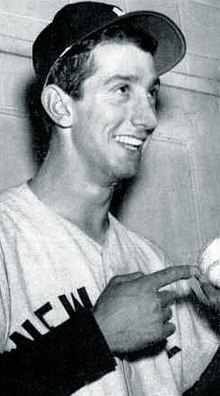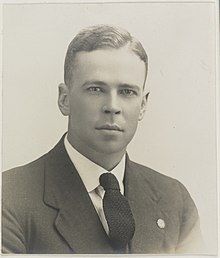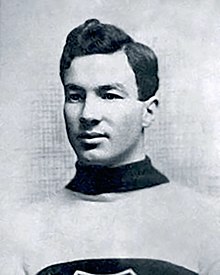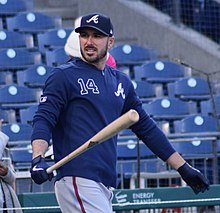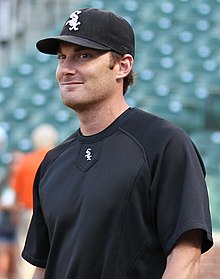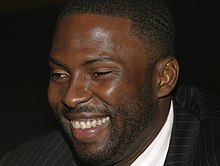Portal:Baseball
Portal maintenance status: (June 2018)
|
| Main page | Content, Categories & Topics | WikiProjects & Things you can do |
The Baseball Portal
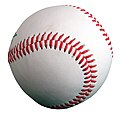
Baseball is a bat-and-ball sport played between two teams of nine players each, taking turns batting and fielding. The game occurs over the course of several plays, with each play generally beginning when a player on the fielding team, called the pitcher, throws a ball that a player on the batting team, called the batter, tries to hit with a bat. The objective of the offensive team (batting team) is to hit the ball into the field of play, away from the other team's players, allowing its players to run the bases, having them advance counter-clockwise around four bases to score what are called "runs". The objective of the defensive team (referred to as the fielding team) is to prevent batters from becoming runners, and to prevent runners advancing around the bases. A run is scored when a runner legally advances around the bases in order and touches home plate (the place where the player started as a batter).
The opposing teams switch back and forth between batting and fielding; the batting team's turn to bat is over once the fielding team records three outs. One turn batting for each team constitutes an inning. A game is usually composed of nine innings, and the team with the greater number of runs at the end of the game wins. Most games end after the ninth inning, but if scores are tied at that point, extra innings are usually played. Baseball has no game clock, though some competitions feature pace-of-play regulations such as the pitch clock to shorten game time.
Baseball evolved from older bat-and-ball games already being played in England by the mid-18th century. This game was brought by immigrants to North America, where the modern version developed. Baseball's American origins, as well as its reputation as a source of escapism during troubled points in American history such as the American Civil War and the Great Depression, have led the sport to receive the moniker of "America's Pastime"; since the late 19th century, it has been unofficially recognized as the national sport of the United States, though in modern times is considered less popular than other sports, such as American football. In addition to North America, baseball spread throughout the rest of the Americas and the Asia–Pacific in the 19th and 20th centuries, and is now considered the most popular sport in parts of Central and South America, the Caribbean, and East Asia, particularly in Japan, South Korea, and Taiwan. (Full article...)
 Featured articles - load new batch
Featured articles - load new batch
-
Image 1Los Angeles Angels center fielder Mike Trout hits a home run on a pitch from New York Mets pitcher Tommy Milone on May 21, 2017.
Baseball is a bat-and-ball sport played between two teams of nine players each, taking turns batting and fielding. The game occurs over the course of several plays, with each play generally beginning when a player on the fielding team, called the pitcher, throws a ball that a player on the batting team, called the batter, tries to hit with a bat. The objective of the offensive team (batting team) is to hit the ball into the field of play, away from the other team's players, allowing its players to run the bases, having them advance counter-clockwise around four bases to score what are called "runs". The objective of the defensive team (referred to as the fielding team) is to prevent batters from becoming runners, and to prevent runners advancing around the bases. A run is scored when a runner legally advances around the bases in order and touches home plate (the place where the player started as a batter).
The initial objective of the batting team is to have a player reach first base safely; this generally occurs either when the batter hits the ball and reaches first base before an opponent retrieves the ball and touches the base, or when the pitcher persists in throwing the ball out of the batter's reach. Players on the batting team who reach first base without being called "out" can attempt to advance to subsequent bases as a runner, either immediately or during teammates' turns batting. The fielding team tries to prevent runs by using the ball to get batters or runners "out", which forces them out of the field of play. The pitcher can get the batter out by throwing three pitches which result in strikes, while fielders can get the batter out by catching a batted ball before it touches the ground, and can get a runner out by tagging them with the ball while the runner is not touching a base. (Full article...) -
Image 2
Tyler Wayne Skaggs (July 13, 1991 – July 1, 2019) was an American left-handed professional baseball starting pitcher who played in Major League Baseball (MLB) for the Arizona Diamondbacks and Los Angeles Angels from 2012 until his death in 2019.
A native of Woodland Hills, California, and a graduate of Santa Monica High School, Skaggs was a supplemental first-round selection for the Angels in the 2009 Major League Baseball draft. He was traded to the Diamondbacks the following year as part of an exchange for pitcher Dan Haren and rose through Arizona's farm system. After two consecutive appearances at the All-Star Futures Game in 2011 and 2012, Skaggs made his major league debut on August 22, 2012, against the Miami Marlins. He remained with the Diamondbacks through the end of the season, but was optioned to the minor leagues in 2013. (Full article...) -
Image 3

Depiction of the game from The Boston Globe
On Saturday, May 1, 1920, the Brooklyn Dodgers and the Boston Braves played to a 1–1 tie in 26 innings, the most innings ever played in a single game in the history of Major League Baseball (MLB). The game was played at Braves Field in Boston before a crowd estimated at 4,000. Both Leon Cadore of Brooklyn and Joe Oeschger of Boston pitched complete games, and with 26 innings pitched, jointly hold the record for the longest pitching appearance in MLB history. Their record is considered unbreakable, as modern pitchers rarely pitch even nine innings, and newer baseball rules have made long extra-innings games a rarity.
The day of the game saw rainy weather, and it was uncertain if the game would be played, but the skies cleared enough to allow it to proceed. Brooklyn scored a run in the fifth inning, and Boston in the sixth; thereafter, the pitchers became increasingly dominant. As the game exceeded eighteen innings, the small crowd at Braves Field cheered both pitchers. The last twenty innings were scoreless, and when darkness started to fall, the umpires called a halt after the twenty-sixth inning, as baseball fields did not yet have artificial lighting. (Full article...) -
Image 4
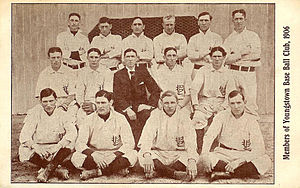
Youngstown Ohio Works (1906), with pitcher Roy Castleton seated in second row, second from left
The Youngstown Ohio Works baseball team was a minor league club that was known for winning the premier championship of the Ohio–Pennsylvania League in 1905, and for launching the professional career of pitcher Roy Castleton a year later. A training ground for several players and officials who later established careers in Major League Baseball, the team proved a formidable regional competitor and also won the 1906 league championship.
During its brief span of activity, the Ohio Works team faced challenges that reflected common difficulties within the Ohio–Pennsylvania League, including weak financial support for teams. Following a dispute over funding, the team's owners sold the club to outside investors, just a few months before the opening of the 1907 season. (Full article...) -
Image 5

James Robert "Loafer" McAleer (July 10, 1864 – April 29, 1931) was an American center fielder, manager, and stockholder in Major League Baseball who assisted in establishing the American League. He spent most of his 13-season playing career with the Cleveland Spiders, and went on to manage the Cleveland Blues, St. Louis Browns, and Washington Senators. Shortly before his retirement, he became a major shareholder in the Boston Red Sox. His career ended abruptly. During his brief tenure as co-owner of the Red Sox, McAleer quarreled with longtime friend and colleague Ban Johnson, president of the American League. In the wake of this disagreement, he sold off his shares in the Red Sox and broke off his relationship with Major League Baseball.
McAleer's rift with Johnson, along with his sudden retirement, damaged his professional reputation, and he received little recognition for his contributions to baseball. Today, he is most often remembered for initiating the customary request that the President of the United States throw out the first ball of the season. (Full article...) -
Image 6
Alfred Manuel "Billy" Martin Jr. (May 16, 1928 – December 25, 1989) was an American Major League Baseball second baseman and manager who, in addition to leading other teams, was five times the manager of the New York Yankees. First known as a scrappy infielder who made considerable contributions to the championship Yankee teams of the 1950s, he then built a reputation as a manager who would initially make bad teams good, before ultimately being fired amid dysfunction. In each of his stints with the Yankees he managed them to winning records before being fired by team owner George Steinbrenner or resigning under fire, usually amid a well-publicized scandal such as Martin's involvement in an alcohol-fueled fight.
Martin was born in a working-class section of Berkeley, California. His skill as a baseball player gave him a route out of his home town. Signed by the Pacific Coast League Oakland Oaks, Martin learned much from Casey Stengel, the man who would manage him both in Oakland and in New York, and enjoyed a close relationship with Stengel. Martin's spectacular catch of a wind-blown Jackie Robinson popup late in Game Seven of the 1952 World Series saved that series for the Yankees, and he was the hitting star of the 1953 World Series, earning the Most Valuable Player award in the Yankee victory. He missed most of two seasons, 1954 and 1955, after being drafted into the Army, and his abilities never fully returned; the Yankees traded him after a brawl at the Copacabana club in New York during the 1957 season. Martin bitterly resented being traded, and did not speak to Stengel for years, a time during which Martin completed his playing career with various teams. (Full article...) -
Image 7
William Harold Ponsford MBE (19 October 1900 – 6 April 1991) was an Australian cricketer. Usually playing as an opening batsman, he formed a successful and long-lived partnership opening the batting for Victoria and Australia with Bill Woodfull, his friend and state and national captain. Ponsford is the only player to twice break the world record for the highest individual score in first-class cricket; Ponsford and Brian Lara are the only cricketers to twice score 400 runs in an innings. Ponsford holds the Australian record for a partnership in Test cricket, set in 1934 in combination with Don Bradman (451 for 2nd wicket)—the man who broke many of Ponsford's other individual records. In fact, he along with Bradman set the record for the highest partnership ever for any wicket in Test cricket history when playing on away soil (451 runs for the second wicket)
Despite being heavily built, Ponsford was quick on his feet and renowned as one of the finest ever players of spin bowling. His bat, much heavier than the norm and nicknamed "Big Bertha", allowed him to drive powerfully and he possessed a strong cut shot. However, critics questioned his ability against fast bowling, and the hostile short-pitched English bowling in the Bodyline series of 1932–33 was a contributing factor in his early retirement from cricket a year and a half later. Ponsford also represented his state and country in baseball, and credited the sport with improving his cricketing skills. (Full article...) -
Image 8Ross with the Montreal Wanderers, circa 1907–18
Arthur Howey Ross (January 13, 1885 – August 5, 1964) was a Canadian professional ice hockey player and executive from 1905 until 1954. Regarded as one of the best defenders of his era by his peers, he was one of the first to skate with the puck up the ice rather than pass it to a forward. He was on Stanley Cup championship teams twice in a playing career that lasted thirteen seasons; in January 1907 with the Kenora Thistles and 1908 with the Montreal Wanderers. Like other players of the time, Ross played for several different teams and leagues, and is noted for his time with the Wanderers while they were members of the National Hockey Association (NHA) and its successor, the National Hockey League (NHL). In 1911, he led one of the first organized player strikes over increased pay. When the Wanderers' home arena burned down in January 1918, the team ceased operations and Ross retired as a player.
After several years as an on-ice official, he was named head coach of the Hamilton Tigers for one season. When the Boston Bruins were formed in 1924, Ross was hired as the first coach and general manager of the team. He later coached the team on three separate occasions until 1945, and stayed as general manager until his retirement in 1954. Ross helped the Bruins finish first place in the league ten times and win the Stanley Cup three times; Ross personally coached the team to two of those victories. After being hired by the Bruins, Ross, along with his wife and two sons, moved to a suburb of Boston, and he became an American citizen in 1938. He died near Boston in 1964. (Full article...) -
Image 9
Derek Sanderson Jeter (/ˈdʒiːtər/ JEE-tər; born June 26, 1974), nicknamed "the Captain", is an American former professional baseball shortstop, businessman, and baseball executive. As a player, Jeter spent his entire 20-year Major League Baseball (MLB) career with the New York Yankees. He was elected to the Baseball Hall of Fame in his first year of eligibility in 2020; he received 396 of 397 possible votes, the second-highest percentage in MLB history (behind only teammate Mariano Rivera) and the highest by a position player. He was the chief executive officer (CEO) and part owner of the league's Miami Marlins from September 2017 to February 2022.
A five-time World Series champion with the Yankees, Jeter is regarded as a central contributor to the franchise's dynasty during the late 1990s and early 2000s for his hitting, base-running, fielding, and leadership. He is the Yankees' all-time career leader in hits (3,465), doubles (544), games played (2,747), stolen bases (358), times on base (4,716), plate appearances (12,602) and at bats (11,195). His accolades include 14 All-Star selections, five Gold Glove Awards, five Silver Slugger Awards, two Hank Aaron Awards, and a 2009 Roberto Clemente Award. Jeter was the 28th player to reach 3,000 hits and finished his career ranked sixth in MLB history in career hits and first among shortstops. In 2017, the Yankees retired his uniform number 2. (Full article...) -
Image 10Paschal before a game during the 1925 New York Yankees season
Benjamin Edwin Paschal (October 13, 1895 – November 10, 1974) was an American baseball outfielder who played eight seasons in Major League Baseball from 1915 to 1929, mostly for the New York Yankees. After two "cup of coffee" stints with the Cleveland Indians in 1915 and the Boston Red Sox in 1920, Paschal spent most of his career as the fourth outfielder and right-handed pinch hitter of the Yankees' Murderers' Row championship teams of the late 1920s. Paschal is best known for hitting .360 in the 1925 season while standing in for Babe Ruth, who missed the first 40 games with a stomach ailment.
During his time in baseball, Paschal was described as a five-tool player who excelled at running, throwing, fielding, hitting for average, and power. However, his playing time with the Yankees was limited because they already had future Baseball Hall of Famers Ruth and Earle Combs, and star Bob Meusel, in the outfield. Paschal was considered one of the best bench players in baseball during his time with the Yankees, and sportswriters wrote how he would have started for most other teams in the American League. He was one of the best pinch hitters in the game during the period, at a time when the term was still relatively new to baseball. (Full article...) -
Image 11
James Francis Thorpe (Meskwaki: Wa-Tho-Huk, translated as "Bright Path"; May 22 or 28, 1887 – March 28, 1953) was an American athlete and Olympic gold medalist. A member of the Sac and Fox Nation, Thorpe was the first Native American to win a gold medal for the United States in the Olympics. Considered one of the most versatile athletes of modern sports, he won two Olympic gold medals in the 1912 Summer Olympics (one in classic pentathlon and the other in decathlon). He also played football (collegiate and professional), professional baseball, and professional basketball.
He lost his Olympic titles after it was found he had been paid for playing two seasons of semi-professional baseball before competing in the Olympics, thus violating the contemporary amateurism rules. In 1983, 30 years after his death, the International Olympic Committee (IOC) restored his Olympic medals with replicas, after ruling that the decision to strip him of his medals fell outside of the required 30 days. Official IOC records still listed Thorpe as co-champion in decathlon and pentathlon until 2022, when it was decided to restore him as the sole champion in both events. (Full article...) -
Image 12
Michael Jeffrey Jordan (born February 17, 1963), also known by his initials MJ, is an American businessman and former professional basketball player. He played 15 seasons in the National Basketball Association (NBA) between 1984 and 2003, winning six NBA championships with the Chicago Bulls. He was integral in popularizing basketball and the NBA around the world in the 1980s and 1990s, becoming a global cultural icon. His profile on the NBA website states, "By acclamation, Michael Jordan is the greatest basketball player of all time."
Jordan played college basketball with the North Carolina Tar Heels. As a freshman, he was a member of the Tar Heels' national championship team in 1982. Jordan joined the Bulls in 1984 as the third overall draft pick and quickly emerged as a league star, entertaining crowds with his prolific scoring while gaining a reputation as one of the best defensive players. His leaping ability, demonstrated by performing slam dunks from the free-throw line in Slam Dunk Contests, earned him the nicknames "Air Jordan" and "His Airness". Jordan won his first NBA title with the Bulls in 1991 and followed that achievement with titles in 1992 and 1993, securing a three-peat. Citing physical and mental exhaustion from basketball and superstardom, Jordan abruptly retired from basketball before the 1993–94 NBA season to play Minor League Baseball in the Chicago White Sox organization. He returned to the Bulls in March 1995 and led them to three more championships in 1996, 1997, and 1998, as well as a then-record 72 regular season wins in the 1995–96 NBA season. Jordan retired for the second time in January 1999, returning for two more NBA seasons from 2001 to 2003 as a member of the Washington Wizards. He was selected to play for the United States national team during his college and NBA careers, winning four gold medals—at the 1983 Pan American Games, 1984 Summer Olympics, 1992 Tournament of the Americas and 1992 Summer Olympics—while also being undefeated. (Full article...) -
Image 13
George Herman "Babe" Ruth (February 6, 1895 – August 16, 1948) was an American professional baseball player whose career in Major League Baseball (MLB) spanned 22 seasons, from 1914 through 1935. Nicknamed "the Bambino" and "the Sultan of Swat", he began his MLB career as a star left-handed pitcher for the Boston Red Sox, but achieved his greatest fame as a slugging outfielder for the New York Yankees. Ruth is regarded as one of the greatest sports heroes in American culture and is considered by many to be the greatest baseball player of all time. In 1936, Ruth was elected to the Baseball Hall of Fame as one of its "first five" inaugural members.
At age seven, Ruth was sent to St. Mary's Industrial School for Boys, a reformatory where he was mentored by Brother Matthias Boutlier of the Xaverian Brothers, the school's disciplinarian and a capable baseball player. In 1914, Ruth was signed to play Minor League baseball for the Baltimore Orioles but was soon sold to the Red Sox. By 1916, he had built a reputation as an outstanding pitcher who sometimes hit long home runs, a feat unusual for any player in the dead-ball era. Although Ruth twice won 23 games in a season as a pitcher and was a member of three World Series championship teams with the Red Sox, he wanted to play every day and was allowed to convert to an outfielder. With regular playing time, he broke the MLB single-season home run record in 1919 with 29. (Full article...) -
Image 14
Osborne Earl Smith (born December 26, 1954) is an American former professional baseball player. Nicknamed "The Wizard of Oz", Smith played shortstop for the San Diego Padres and St. Louis Cardinals in Major League Baseball, winning the National League Gold Glove Award for defensive play at shortstop for 13 consecutive seasons. A 15-time All-Star, Smith accumulated 2,460 hits and 580 stolen bases during his career, and won the National League Silver Slugger Award as the best hitter at shortstop in 1987. He was elected to the Baseball Hall of Fame in his first year of eligibility in 2002. He was also elected to the St. Louis Cardinals Hall of Fame in the inaugural class of 2014.
Smith was born in Mobile, Alabama; his family moved to Watts, Los Angeles, when he was six years old. While participating in childhood athletic activities, Smith possessed quick reflexes; he went on to play baseball at Locke High School in Los Angeles, then at California Polytechnic State University, San Luis Obispo. Drafted as an amateur player by the Padres, Smith made his major league debut in 1978. He quickly established himself as an outstanding fielder, and later became known for performing backflips on special occasions while taking his position at the beginning of a game. Smith won his first Gold Glove Award in 1980 and made his first All-Star Game appearance in 1981. (Full article...) -
Image 15

WSNS-TV (channel 44) is a television station in Chicago, Illinois, United States, serving as the local outlet for the Spanish-language network Telemundo. It is owned and operated by NBCUniversal's Telemundo Station Group alongside NBC outlet WMAQ-TV (channel 5). The two stations share studios at the NBC Tower on North Columbus Drive in the city's Streeterville neighborhood and broadcast from the same transmitter atop the Willis Tower in the Chicago Loop.
WSNS-TV began broadcasting in 1970. Originally specializing in the automated display of news headlines, it evolved into Chicago's third full-fledged independent station, carrying movies, local sports, and other specialty programming. This continued until 1980, when WSNS became the Chicago-area station for ON TV, an over-the-air subscription television (STV) service owned by Oak Industries, which took a minority ownership stake in the station. While ON TV was successful in Chicago and the subscription system became the second-largest in the country by total subscribers, the rise of cable television precipitated the end of the business in 1985, with WSNS-TV as the last ON TV station standing. (Full article...)
General images - load new batch
-
Image 1Alexander Cartwright, father of modern baseball (from History of baseball)
-
Image 2Defensive positions on a baseball field, with abbreviations and scorekeeper's position numbers (not uniform numbers) (from Baseball)
-
Image 3Fenway Park, home of the Boston Red Sox. The Green Monster is visible beyond the playing field on the left. (from Baseball)
-
Image 6Pick-off attempt on runner (in red) at first base (from Baseball rules)
-
Image 7Baserunners generally stand a short distance away from their base between pitches, preparing themselves to either go back or steal the next base. (from Baseball rules)
-
Image 8Diagram of a baseball field Diamond may refer to the square area defined by the four bases or to the entire playing field. The dimensions given are for professional and professional-style games. Children often play on smaller fields. (from Baseball)
-
Image 91906 World Series, infielders playing "in" for the expected bunt and the possible play at the plate with the bases loaded (from Baseball rules)
-
Image 10The strike zone determines the result of most pitches, and varies in vertical length for each batter. (from Baseball)
-
Image 11Cover of Official Base Ball Rules, 1921 edition, used by the American League and National League (from Baseball rules)
-
Image 12A batter follows through after swinging at a pitched ball. (from Baseball rules)
-
Image 13A runner sliding into home plate and scoring. (from Baseball)
-
Image 15Cy Young—the holder of many major league career marks, including wins and innings pitched, as well as losses—in 1908. MLB's annual awards for the best pitcher in each league are named for Young. (from Baseball)
-
Image 16Jackie Robinson in 1945, with the era's Kansas City Royals, a barnstorming squad associated with the Negro American League's Kansas City Monarchs (from Baseball)
-
Image 19The strike zone, which determines the outcome of most pitches, varies in vertical length depending on the batter's typical height while swinging. (from Baseball rules)
-
Image 20A game from the Cantigas de Santa Maria, c. 1280, involving tossing a ball, hitting it with a stick and competing with others to catch it (from History of baseball)
-
Image 21Japanese-Americans spectating a World War II-era game while in an internment camp. America's ties to immigrants and to Japan have been deeply shaped by a shared baseball heritage. (from History of baseball)
-
Image 22A well-worn baseball (from Baseball)
-
Image 23The NL champion New York Giants baseball team, 1913. Fred Merkle, sixth in line, had committed a baserunning gaffe in a crucial 1908 game that became famous as Merkle's Boner. (from History of baseball)
-
Image 24Sadaharu Oh managing the Japan national team in the 2006 World Baseball Classic. Playing for the Central League's Yomiuri Giants (1959–80), Oh set the professional world record for home runs. (from Baseball)
-
Image 26Sadaharu Oh managing the Japan national team in the 2006 World Baseball Classic. Playing for the Central League's Yomiuri Giants (1959–80), Oh set the professional world record for home runs with 868. (from History of baseball)
-
Image 28An Afghan girl playing baseball in August 2002 (from Baseball)
-
Image 30In May 2010, the Philadelphia Phillies' Roy Halladay pitched the 20th major league perfect game. That October, he pitched only the second no-hitter in MLB postseason history. (from History of baseball)
-
Image 32Pesäpallo, a Finnish variation of baseball, was invented by Lauri "Tahko" Pihkala in the 1920s, and after that, it has changed with the times and grown in popularity. Picture of Pesäpallo match in 1958 in Jyväskylä, Finland. (from Baseball)
-
Image 33Baseball games sometimes end in a walk-off home run, with the batting team usually gathering at home plate to celebrate the scoring of the winning run(s). (from Baseball rules)
-
Image 34A pitcher handing off the ball after being taken out of the game during a mound meeting. (from Baseball)
-
Image 35Rickey Henderson—the major leagues' all-time leader in runs and stolen bases—stealing third base in a 1988 game (from Baseball)
-
Image 36Pitchers are generally substituted during mound visits (team gatherings at the pitcher's mound). (from Baseball rules)
-
Image 37By the 1860s Civil War, baseball (bottom) had overtaken its fellow bat-and-ball sport cricket (top) in popularity within the United States. (from History of baseball)
-
Image 38The American Tobacco Company's line of baseball cards featured shortstop Honus Wagner of the Pittsburgh Pirates from 1909 to 1911. In 2007, the card shown here sold for $2.8 million. (from Baseball)
-
Image 39A first baseman receives a pickoff throw, as the runner dives back to first base. (from Baseball)
-
Image 40Two players on the baseball team of Tokyo, Japan's Waseda University in 1921 (from Baseball)
-
Image 41The typical motion of a right-handed pitcher (from Baseball rules)
-
Image 42Jackie Robinson in 1945, with the era's Kansas City Royals, a barnstorming squad associated with the Negro American League's Kansas City Monarchs (from History of baseball)
-
Image 432013 World Baseball Classic championship match between the Dominican Republic and Puerto Rico, March 20, 2013 (from Baseball)
-
Image 44A New York Yankees batter (Andruw Jones) and a Boston Red Sox catcher at Fenway Park (from Baseball)
-
Image 45The standard fielding positions (from Baseball rules)
 Good articles - load new batch
Good articles - load new batch
-
Image 1
The Redbirds–Sounds rivalry is a Minor League Baseball rivalry between Tennessee's two Triple-A baseball teams, the Memphis Redbirds and the Nashville Sounds. The teams compete in the West Division of the International League. Their games are played at Memphis' AutoZone Park and Nashville's First Horizon Park. From 2012 to 2015, the rivalry was incorporated into a promotion called the I-40 Cup Series.
Separated by an approximately 200-mile (320 km) stretch of Interstate 40, competition between professional baseball teams from Memphis and Nashville began in 1885 in the original Southern League. The cities later fielded teams in the Southern Association and modern Southern League. The rivalry between the Redbirds and Sounds began in 1998 when both teams became members of the Pacific Coast League and continued in 2021 following placement in the Triple-A East, which became the International League in 2022. (Full article...) -
Image 2Studios for KTXH and KRIV on Southwest Freeway in Houston
KTXH (channel 20), branded as My20 Vision, is a television station in Houston, Texas, United States, airing the MyNetworkTV programming service. It is owned and operated by Fox Television Stations alongside Fox outlet KRIV (channel 26). The two stations share studios on Southwest Freeway (I-69/US 59) in Houston; KTXH's transmitter is located near Missouri City, Texas.
KTXH began broadcasting in November 1982 as Houston's third independent station. A month after going on air, its broadcast tower collapsed in a construction accident that killed five people. The station recovered and emerged as Houston's sports independent, beginning long associations with the Houston Astros and Houston Rockets that continued uninterrupted through the late 1990s and sporadically until the early 2010s. Not long after starting up, KTXH was sold twice in rapid succession for large amounts. However, when the independent station trade, advertising market, and regional economy cooled, it was sold again for less than half of its previous value. The Paramount Stations Group acquired KTXH and other stations in two parts between 1989 and 1991, bringing much-needed stability. (Full article...) -
Image 3
Matthew Ryan Joyce (born August 3, 1984) is an American former professional baseball outfielder, who played 14 seasons in Major League Baseball (MLB). Between 2008 and 2021, he played for eight MLB teams, most notably the Tampa Bay Rays, with whom he was named an MLB All-Star in 2011.
Raised by a single father in Tampa, Florida, Joyce frequently attended Rays games at Tropicana Field as a child. The Detroit Tigers attended an exhibition game that Joyce played with Florida Southern College and selected him in the 12th round of the 2005 MLB Draft. Joyce debuted with the Tigers in 2008 and was traded to the Rays the following season. After five years in St. Petersburg, Florida, Joyce was traded to the Los Angeles Angels, where his performance suffered after a 2015 concussion. (Full article...) -
Image 4"A Hero Sits Next Door" is the fifth episode in the first season of the American animated television series Family Guy. It originally aired on the Fox network in the United States on May 2, 1999. The episode features the introduction of Joe Swanson, who would become a main character in the series. Peter Griffin must find a replacement player for an upcoming softball game. Peter eventually convinces Joe to play for the team after learning that he played baseball in college. When Joe shows up the following morning, Peter realizes that Joe is in a wheelchair. Joe turns out to be a great player, and the team wins the game. Peter becomes jealous of Joe and tries to become a hero. In a subplot, Meg Griffin tries to get Joe's son Kevin to notice her.
"A Hero Sits Next Door" was directed by Monte Young and written by the writing team of Mike Barker and Matt Weitzman. It featured guest performances by actress Suzie Plakson, figure skater Michelle Kwan, as well as actors Wally Wingert and Carlos Alazraqui. Much of the episode features a cutaway style of humor that is typically used in Family Guy, many of which feature cultural references and include Super Friends, Pez, Teletubbies, and the assassinations of John F. Kennedy and Robert F. Kennedy. (Full article...) -
Image 5Maglie's 1953 Bowman Gum card
Salvatore Anthony Maglie (April 26, 1917 – December 28, 1992) was an American Major League Baseball pitcher and later, a scout and a pitching coach. He played from 1945 to 1958 for the New York Giants, Cleveland Indians, Brooklyn Dodgers, New York Yankees, and St. Louis Cardinals. Maglie was known as "Sal the Barber", because he gave close shaves—that is, pitched inside to hitters. A gentle personality off the field went unnoticed during games, his foreboding physical appearance contributing to his menacing presence on a pitcher's mound. He was the last of 14 players to play for the Giants, Dodgers and Yankees at a time when all three teams were in New York City. During a 10-year major league baseball career, Maglie compiled 119 wins, 862 strikeouts, and a 3.15 earned run average.
Born and raised in Niagara Falls, New York, Maglie had to play ball secretly growing up because his parents discouraged it. Signed by the Buffalo Bisons of the International League in 1938, he pitched in the minor leagues for five years, then took two years off during World War II to work at a Niagara Falls defense plant. He started pitching again with the Jersey City Giants in 1945, then made his major league debut with the Giants later that year at the age of 28, starting 10 games for the Giants. It would be five years before he returned to the major leagues, as he joined the upstart Mexican League in 1946 and was subsequently blacklisted from Major League Baseball (MLB) for five years by Commissioner Happy Chandler. Not until he was 33 in 1950 did Maglie become a full-time pitcher in the major leagues. (Full article...) -
Image 6
Thomas P. "Oyster" Burns (September 6, 1864 – November 11, 1928) was an American professional baseball player whose career spanned 15 seasons, 11 of which were spent with the Major League Baseball (MLB) Wilmington Quicksteps (1884), Baltimore Orioles (1884–85, 1887–88), Brooklyn Bridegrooms (1888–1895), and New York Giants (1895). Burns, who predominately played as an outfielder, also played as a shortstop, second baseman, third baseman, and pitcher. Over his career, Burns compiled a career batting average of .300 with 870 runs scored, 1,392 hits, 224 doubles, 129 triples, 65 home runs, and 834 runs batted in (RBI) in 1,188 games played. Although the majority of his career was spent in the major leagues, Burns also played in minor league baseball. He made his MLB debut at the age of 19 and was listed as standing 5 feet 8 inches (173 cm) and weighing 183 pounds (83 kg).
Burns, nicknamed "Oyster" because he sold shellfish in the off-season, was described as a "loudmouth" and having "an irritating voice and personality". He led the Bridegrooms to an American Association championship in 1889 and a National League pennant in 1890. After retiring from baseball, Burns died on November 11, 1928, in Brooklyn, New York. (Full article...) -
Image 7John Fulton Woods (January 18, 1898 – October 4, 1946) was a professional baseball pitcher and police officer. He appeared in one game in Major League Baseball (MLB) for the Boston Red Sox during the 1924 season. Listed at 6 feet 0 inches (1.83 m), 175 lb (79 kg). During his career, Woods batted and threw right-handed.
Born in Princeton, West Virginia, Woods played college baseball at West Virginia University for the Mountaineers. After briefly attending law school, he was signed by the Red Sox and pitched one inning in his only MLB game, an 8–4 loss to the Chicago White Sox on September 16, 1924. He gave up no runs but walked three batters. Woods then played minor league baseball before joining the Norfolk Police Department in 1929. He became the chief of the department in 1939, serving in that capacity for the rest of his life until he was killed while responding to an auto accident in 1946. (Full article...) -
Image 8"Ode to the Mets" is a song by American rock band the Strokes, the ninth and closing track on their sixth studio album, The New Abnormal (2020). Singer Julian Casablancas began writing the song while waiting for a subway train following the New York Mets' loss in the 2016 National League Wild Card Game at Citi Field. Its title was originally conceived as a joke; however, drummer Fabrizio Moretti, finding it a fitting metaphor for the lyrical themes, convinced Casablancas to keep it.
The Strokes first performed the song live at their New Year's Eve 2019 concert at the Barclays Center. It has been regarded by multiple critics as one of the highlights from The New Abnormal and also reached number 27 on the Billboard Hot Rock Songs chart. A music video for the song, directed by Warren Fu, was released on July 24, 2020, coinciding with that year's delayed Opening Day for the Mets. (Full article...) -
Image 9
Philip Humber of the Chicago White Sox pitched a perfect game against the Seattle Mariners by retiring all 27 batters he faced on April 21, 2012, as the White Sox defeated the Mariners 4–0. It was the 21st perfect game in Major League Baseball (MLB) history and the third by a member of the White Sox, and remains the earliest calendar date for a perfect game in MLB history. It was Humber's first career complete game, although he had come close to achieving no-hitters on several occasions at several levels of organized baseball. The game was played in Seattle and broadcast regionally by Fox Sports in the two teams' metropolitan areas.
Humber, a top pitching prospect from a Texas high school, attended Rice University, where he had a successful career. A high draft pick by the New York Mets, he debuted in MLB for the Mets before headlining a group of four prospects traded to the Minnesota Twins for Johan Santana. After two ineffective seasons with the Twins, Humber pitched a season for the Kansas City Royals. Acquired on waivers by the Chicago White Sox in 2011, Humber had his first successful season in an MLB starting rotation. The perfect game, Humber's 30th career start and his 2nd of the 2012 season, totaled 96 pitches. (Full article...) -
Image 10

Charles Hodes (c. 1848 – February 14, 1875) was an American professional baseball player who played as a catcher, infielder, and outfielder in the National Association for three seasons from 1871 to 1874. A Brooklyn native, Hodes played one season each for the Chicago White Stockings, Troy Haymakers, and Brooklyn Atlantics. He had a career batting average of .231 in 63 total games before dying from tuberculosis in 1875. (Full article...) -
Image 11
Milton Obelle Bradley, Jr. (born April 15, 1978) is an American former professional baseball outfielder. Standing 6 feet (1.8 m) and weighing 215 pounds (98 kg), Bradley was a switch hitter who threw right-handed. During an 11-year career in Major League Baseball, Bradley played with the Montreal Expos (2000–01), Cleveland Indians (2001–03), Los Angeles Dodgers (2004–05), Oakland Athletics (2006–07), San Diego Padres (2007), Texas Rangers (2008), Chicago Cubs (2009), and Seattle Mariners (2010–11). His career was also marred by legal troubles and several notable on-field incidents.
Born in Harbor City, California, Bradley attended Long Beach Polytechnic High School before he was drafted by the Expos in the 1996 Major League Baseball draft. After playing four seasons of minor league baseball for the organization, he made his major league debut on July 19, 2000. In 2001, Bradley was traded to the Cleveland Indians in exchange for pitching prospect Zach Day; he was again traded in 2004 to the Los Angeles Dodgers. After playing in 216 games for the Dodgers, the most among all teams he has played for, Bradley was traded to the Oakland Athletics for Andre Ethier. Bradley was traded to the Padres in 2007, was granted free agency after one season with the team, and signed with the Texas Rangers in 2007. He was voted to the 2008 Major League Baseball All-Star Game with the Rangers, and led the American League with a .436 on-base percentage and a .999 on-base plus slugging percentage. For the year, Bradley finished 17th in American League Most Valuable Player Award voting. (Full article...) -
Image 12
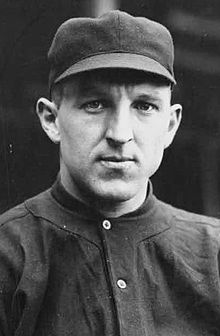
Charles Lincoln "Buck" Herzog (July 9, 1885 – September 4, 1953) was an American infielder and manager in Major League Baseball who played for four National League clubs between 1908 and 1920: the New York Giants, the Boston Braves, the Cincinnati Reds, and the Chicago Cubs. His flexibility sets him apart from other major leaguers, as he demonstrated great skill as a second baseman, shortstop, and third baseman.
Born in Baltimore, Maryland, Herzog grew up on a farm in nearby Ridgely. After attending the Maryland Agricultural College, he played one season in the minor leagues before the Giants selected him in the Rule 5 Draft. Herzog batted .300 as a rookie but struggled in 1909 and was traded to Boston before 1910. He cemented himself as an everyday player over the next two years, then was reacquired by the Giants in 1911, with whom he would reach three straight World Series. He struggled to hit in the 1911 World Series but set a record that would stand for over 50 years with 12 hits in the 1912 World Series, though the Giants lost all three of the series. Traded to the Reds before the 1914 season, he served as a player-manager for the Reds through the first half of the 1916 season, though the team had a losing record in each of those years. The Giants reacquired him halfway through 1916, naming him the team captain. After a famous fight with Ty Cobb during 1917 spring training, he played in his fourth and final World Series, though he made a key error in Game 5 as the Giants were defeated in six games. Herzog spent 1918 with Boston, was traded to Chicago in the middle of 1919, and played one last year with the Cubs in 1920, a season that saw his reputation tarnished by unsubstantiated accusations of gambling on baseball games. (Full article...) -
Image 13
Robert Lee Dodd (November 11, 1908 – June 21, 1988) was an American college football player and coach, college baseball coach, and college athletics administrator. He served as the head football coach at Georgia Tech from 1945 to 1966, compiling a record of 165–64–8. His teams won consecutive Southeastern Conference (SEC) title in 1951 and 1952, and his 1952 Georgia Tech Yellow Jackets football team won the 1953 Sugar Bowl and was recognized as a national champion by a number of selectors though they finished second behind Michigan State in both major polls. Dodd was also Georgia Tech's head baseball coach from 1932 to 1939, tallying a mark of 43–64–2, and the school's athletic director from 1950 until 1976. All together, Dodd served Georgia Tech 57 years in various capacities.
Dodd starred as quarterback at the University of Tennessee, playing for teams coached by Robert Neyland from 1928 to 1930. He also lettered in baseball, basketball, and track at Tennessee. He was a member of Sigma Nu fraternity. Dodd began his coaching career at Georgia Tech, working as an assistant under William Alexander from 1931 until succeeding Alexander as head football coach in 1945. Dodd was inducted to the College Football Hall of Fame as a player in 1959 and a coach in 1993. He is one of four individuals to be so honored, along with Amos Alonzo Stagg, Bowden Wyatt, and Steve Spurrier. (Full article...) -
Image 14
Ross Middlebrook "Pep" Youngs (April 10, 1897 – October 22, 1927) was an American professional baseball player. Nicknamed "Pep", he played ten seasons in Major League Baseball for the New York Giants from 1917 through 1926, playing right field almost exclusively. Youngs was a part of the Giants teams that won four consecutive National League pennants and the 1921 and 1922 World Series.
From Shiner, Texas, Youngs excelled at baseball and American football at the West Texas Military Institute. After beginning his professional career in minor league baseball, Youngs was signed by the Giants in 1916. Youngs had a lifetime .322 batting average with the Giants and batted over .300 nine times in his career, including eight consecutive seasons. His career was cut short by illness, however, as he died at the age of 30 of Bright's disease. (Full article...) -
Image 15
Eric Michael Surkamp (born July 16, 1987) is an American former Major League Baseball (MLB) pitcher who played for the San Francisco Giants, Chicago White Sox, Los Angeles Dodgers, and Oakland Athletics from 2011 to 2016. He also pitched for the Hanwha Eagles of the KBO League in 2016. Surkamp batted and threw left-handed with his fastball averaging 89 miles per hour (143 km/h).
Growing up, Surkamp helped Moeller High School become Ohio state baseball champions in 2004. He played college baseball at North Carolina State University (NC State) and was a member of Team USA in 2007. Drafted by the Giants in the sixth round in the 2008 MLB Draft, he was called up in August 2011 after posting a 2.02 earned run average (ERA), which led the Eastern League. He had a 2–2 record with the Giants and was considered a fringe candidate for the team's Opening Day roster in 2012, though he wound up missing that season due to Tommy John surgery. He made only one start for the Giants in 2013, allowing seven runs in 2+2⁄3 innings. in a 9–3 loss to the Cincinnati Reds. (Full article...)
Did you know (auto-generated) - load new batch

- ... that Julie Croteau is credited as being the first woman to play National Collegiate Athletic Association men's college baseball?
- ... that before his Major League Baseball career, Leo Posada represented Cuba internationally in cycling?
- ... that the only run scored by John Gamble was a game-winner?
- ... that a painting by Major League Baseball player Gene Locklear was hung in the White House?
- ... that Devin Futrell used a post to dodge a draft?
- ... that Jenny Cavnar is the first female primary play-by-play announcer in Major League Baseball history?
- ... that baseball player Mark Littell developed an anatomically correct athletic cup called the "Nutty Buddy"?
- ... that baseball player Dwight Smith recorded a demo rhythm and blues album during the 1993–94 offseason?
Quotes
| You spend a good piece of your life gripping a baseball, and in the end it turns out that it was the other way around all the time. |
 Featured lists - load new batch
Featured lists - load new batch
-
Image 1

Evan Longoria (2008) is the only Rays' first-round pick to win a Rookie of the Year Award with the team.
The Tampa Bay Rays are a Major League Baseball franchise based in St. Petersburg, Florida. The Rays (formerly the Tampa Bay Devil Rays) compete in the American League East division. Since the franchise was established in 1995, the Rays have selected 36 players in the first round. Officially known as the "First-Year Player Draft", the Rule 4 Draft is Major League Baseball's primary mechanism for assigning amateur baseball players from high schools, colleges, and other amateur baseball clubs to its teams. The draft order is determined based on the previous season's standings, with the team possessing the worst record receiving the first pick. In addition, teams which lost free agents in the previous off-season may be awarded compensatory or supplementary picks. The First-Year Player Draft is unrelated to the 1997 expansion draft in which the Rays filled their roster.
Of the 36 players the Rays have selected in the first round, 10 have been outfielders and 12 have been drafted exclusively as pitchers. Of the 12 pitchers, eight were right-handed and four were left-handed. The Rays have also drafted five shortstops, four third basemen, two catchers, one second baseman, and one first baseman. In addition to these, one player (2017 pick Brendan McKay) was drafted as both a left-handed pitcher and a first baseman. Twenty players were drafted out of high school, 12 were drafted out of four-year colleges, and one was drafted from a junior college. Two players were drafted from Rice University in Houston, Texas in consecutive years. (Full article...) -
Image 2
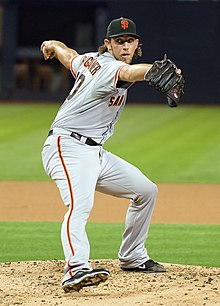
Madison Bumgarner, the 2014 National League Championship Series Most Valuable Player, won both this award and the World Series MVP in the same season.
The League Championship Series Most Valuable Player (MVP) Award is given annually to the Major League Baseball (MLB) players deemed to have the most impact on their teams' performances in each of the two respective League Championship Series that comprise the penultimate round of the MLB postseason. The award is given separately for a player in both the American League Championship Series and the National League Championship Series. It has been presented in the National League (NL) since 1977, and in the American League (AL) since 1980. Dusty Baker won the inaugural award in 1977 with the Los Angeles Dodgers, and Frank White won the first AL award in 1980 with the Kansas City Royals. The eleven Hall of Famers to win LCS MVPs include Roberto Alomar, George Brett, Dennis Eckersley, Rickey Henderson, David Ortiz, Kirby Puckett, Ozzie Smith, Willie Stargell, John Smoltz, Iván Rodríguez, and Mariano Rivera.
Three players have won the award twice: Steve Garvey (1978, 1984), Dave Stewart (1990, 1993), and Orel Hershiser (1988, 1995). Incidentally, all three of these players won their two awards with two different teams. Nine players have gone on to win the World Series MVP Award in the same season in which they won the LCS MVP—eight from the NL and one from the AL. Three players have won while playing for the losing team in the series: Fred Lynn played for the 1982 California Angels; Mike Scott pitched for the 1986 Houston Astros; and Jeffrey Leonard played for the 1987 San Francisco Giants. Two players have shared the award in the same year three times, all in the NL; Rob Dibble and Randy Myers for the 1990 Cincinnati Reds, the Chicago Cubs' Jon Lester and Javier Báez in 2016, and Chris Taylor and Justin Turner of the Los Angeles Dodgers in 2017. (Full article...) -
Image 3

Jason Varitek in 2009 with the captain insignia on his chest
The Boston Red Sox, a professional baseball franchise in Major League Baseball (MLB), has given the title of captain to select players since the team's inaugural season as a member of the American League in 1901 (the team was known as the Boston Americans through the 1907 season). For various seasons during the team's history, the position has been vacant; while in early baseball a captain was responsible for many of the functions now assumed by managers and coaches, the title is purely honorary in modern professional baseball. Since the end of World War II, only three players have served as captain of the Red Sox. The most recent was catcher Jason Varitek, who was captain during the 2005–2011 seasons, and wore a distinctive "C" on the left side of his jersey, similar to captains in the National Hockey League. (Full article...) -
Image 4The San Diego Padres are an American professional baseball team based in San Diego. The Padres compete in Major League Baseball (MLB) as a member club of the National League (NL) West Division. Since the institution of MLB's Rule 4 Draft, the Padres have selected 73 players in the first round. Officially known as the "First-Year Player Draft", the Rule 4 Draft is MLB's primary mechanism for assigning players from high schools, colleges, and other amateur clubs to its franchises. The draft order is determined based on the previous season's standings, with the team possessing the worst record receiving the first pick. In addition, teams which lost free agents in the previous off-season may be awarded compensatory or supplementary picks. The First-Year Player Draft is unrelated to the 1968 expansion draft in which the Padres initially filled their roster.
Of the 73 players picked in the first round by San Diego, 32 have been pitchers, the most of any position; 20 of these were right-handed, while 12 were left-handed. Fourteen outfielders were selected, while ten shortstops, seven catchers, five third basemen, and four first basemen were taken as well. The team has also drafted one player at second base. Eleven of the players came from high schools or universities in the state of California, and Florida and Georgia follow with ten and six players, respectively. (Full article...) -
Image 5
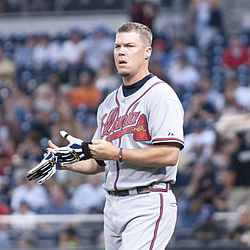
Chipper Jones won the National League MVP Award in 1999, four years after winning a World Series ring.
The Atlanta Braves are a Major League Baseball (MLB) franchise based in Atlanta, Georgia. They play in the National League East division. Officially known as the "First-Year Player Draft", the Rule 4 Draft is MLB's primary mechanism for assigning players from high schools, colleges, and other amateur clubs to its franchises. The draft order is determined based on the previous season's standings, with the team possessing the worst record receiving the first pick. In addition, teams which lost free agents in the previous off-season may be awarded compensatory or supplementary picks. Since the establishment of the draft in 1965, the Braves have selected 56 players in the first round.
Of those 56 players, 27 have been pitchers, the most of any position; 15 of these were right-handed, while 12 were left-handed. The Braves have also selected eight outfielders, seven shortstops, five catchers, four third basemen, three first basemen, and two second basemen in the initial round of the draft. The franchise has drafted nine players from colleges or high schools in the state of Florida, more than any other state. Eight more selections have come from their home state of Georgia. Two selections have come from outside the 50 United States: Luis Atilano (2003) is from the Commonwealth of Puerto Rico, and Scott Thorman (2000) is from Ontario, Canada. (Full article...) -
Image 6On November 17, 1992, during the 1992–93 offseason, Major League Baseball (MLB) held an expansion draft in New York City to allow two expansion teams, the Florida Marlins and Colorado Rockies, to build their rosters prior to debuting in the National League's (NL) East and West divisions, respectively, in the 1993 MLB season.
The 1990 collective bargaining agreement between MLB owners and the MLB Players Association allowed the NL to expand by two members to match the American League (AL). In June 1991, MLB accepted bids of groups from Miami, Florida, and Denver, Colorado, with debuts set for 1993. (Full article...) -
Image 7

David Wright, one of the Mets' first-round picks in 2001
The New York Mets are a Major League Baseball franchise based in New York City. They play in the National League East division. Since the institution of Major League Baseball's Rule 4 Draft, the Mets have selected 63 players in its first round. Officially known as the "First-Year Player Draft", the Rule 4 Draft is Major League Baseball's primary mechanism for assigning amateur baseball players from high schools, colleges, and other amateur baseball clubs to its teams. The draft order is determined based on the previous season's standings, and the team that had the worst record receives the first pick. In addition, teams that lost free agents in the previous off-season may be awarded compensatory or supplementary picks. The First-Year Player Draft is unrelated to the 1961 expansion draft in which the Mets initially filled their roster.
Of the 63 players picked in the first round by the Mets, 25 have been pitchers, the most of any position; 18 of these were right-handed, while seven were left-handed. 18 of the players picked in the initial round were outfielders, while eight shortstops, six catchers, and three third basemen were selected. The team also selected two players at first base and one at second base. 14 of the players came from high schools or universities in the state of California, while Florida and Texas follow, with nine and five players, respectively. (Full article...) -
Image 8

Alex Cora (waving) is the most recent manager to lead the Red Sox to a World Series championship.
The Boston Red Sox are a professional baseball team based in Boston, Massachusetts. The Red Sox are members of the American League (AL) East Division in Major League Baseball (MLB). They have competed since 1901, initially as the Boston Americans (1901–1907), and under their current name since 1908. Since 1912, the Red Sox have played their home games at Fenway Park. In baseball, the head coach of a team is called the manager, or more formally, the field manager. There have been 48 different managers in franchise history; the current manager is Alex Cora, who previously managed the team during the 2018 and 2019 seasons and was re-hired by the team on November 6, 2020.
Jimmy Collins was the first manager of the franchise, managing from 1901 to 1906. Among all Red Sox managers, Joe Cronin managed the most regular season games (2,007) and registered the most regular season wins (1,071), while Terry Francona managed the most playoff games (45) and registered the most playoff wins (28). The most World Series championships won by a Red Sox manager is two, accomplished by Bill Carrigan (1915 and 1916) and Francona (2004 and 2007). John McNamara and Jimy Williams are the only two Red Sox managers to win the AL Manager of the Year Award, in 1986 and 1999, respectively. (Full article...) -
Image 9
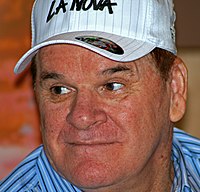
Pete Rose is the all-time MLB hits leader with 4,256 hits.
The 3,000-hit club is the group of 33 batters who have collected 3,000 or more regular-season hits in their careers in Major League Baseball (MLB). Reaching 3,000 hits has been "long considered the greatest measure of superior bat handling" and is often described as a guarantee of eventual entry into the Baseball Hall of Fame.
Cap Anson was the first MLB player to reach 3,000 hits, although his precise career hit total is unclear. Two players—Nap Lajoie and Honus Wagner—reached 3,000 hits during the 1914 season. Ty Cobb did so in 1921 and became the first player in MLB history to reach 4,000 hits in 1927, ultimately finishing his career with 4,191. Pete Rose, the current hit leader, became the second player to reach 4,000 hits on April 13, 1984, and surpassed Cobb in September 1985, finishing his career with 4,256. Roberto Clemente's career ended with precisely 3,000 hits, which he reached in the last at bat of his career on September 30, 1972. (Full article...) -
Image 10Lou Piniella won the 2008 National League Manager of the Year Award, and won twice in the American League.
In Major League Baseball, the Manager of the Year Award is an honor given annually since 1983 to two outstanding managers, one each in the American League (AL) and the National League (NL). The winner is voted on by 30 members of the Baseball Writers' Association of America (BBWAA). Each submits a vote for first, second, and third place among the managers of each league.[a] The manager with the highest score in each league wins the award.
Several managers have won the award in a season in which they led their team to 100 or more wins. They are:- Lou Piniella – 116 (Seattle Mariners, 2001)
- Joe Torre – 114 (New York Yankees, 1998)
- Gabe Kapler – 107 (San Francisco Giants, 2021)
- Sparky Anderson – 104 (Detroit Tigers, 1984)
- Tony La Russa – 104 (Oakland Athletics, 1988)
- Dusty Baker – 103 (San Francisco Giants, 1993)
- Larry Dierker – 102 (Houston Astros, 1998)
- Whitey Herzog – 101 (St. Louis Cardinals, 1985)
- Rocco Baldelli – 101 (Minnesota Twins, 2019)
- Buck Showalter – 101 (New York Mets, 2022)
- Brandon Hyde – 101 (Baltimore Orioles, 2023)
- Kevin Cash – 100 (Tampa Bay Rays, 2021)
-
Image 11

Ty Cobb won more batting titles than any other player, though the precise number is unclear because of the race in the 1910 American League.
In baseball, batting average (AVG) is a measure of a batter's success rate in achieving a hit during an at bat. In Major League Baseball (MLB), it is calculated by dividing a player's hits by his at bats (AB). In MLB, a player in each league[L] wins the "batting title" each season for having the highest batting average that year. The American League (AL) winner is known as the "Rod Carew American League Batting Champion", while the National League (NL) leader is designated the "Tony Gwynn National League Batting Champion". Since 1957, a player must have 3.1 plate appearances (PA) per scheduled game in that league (for a total of 502 over the current 162-game season) to qualify for the batting title. However, if a player's lead in AVG is sufficiently large that enough hitless at bats can be added to reach this requirement and the player still would have the highest batting average, he wins the title. Tony Gwynn, for example, had 159 hits in 451 ABs in 1996 (.353 average) but only 498 PAs. Gwynn's batting average would have dropped to .349 (159 hits in 455 ABs) with four hitless ABs added to reach the 502 PA requirement, but this would still have been higher than the next-highest eligible player (Ellis Burks with a .344 average), so he was awarded the 1996 NL batting title.
MLB officially incorporated Negro League statistics into its record book on Wednesday, May 29, 2024. On December 16, 2020, MLB announced that the records of Negro League Baseball from 1920-1948 would be designated as major league status. From 2020-2024, MLB and the Elias Sports Bureau, completed a comprehensive review of the Seamheads database in coordination with Retrosheet. The MLB database combines statistics from the Negro Leagues with existing data from the AL, NL, and other Major Leagues throughout history. As such, seven different leagues that existed during that time period are now recognized as being on the same level as MLB, which include: the Negro National League (I) (1920-1931); the Eastern Colored League (1923-1928); the American Negro League (1929); the East-West League (1932); the Negro Southern League (1932); the Negro National League (II) (1933-1948); and the Negro American League (1937-1948).
The first batting average champion in the NL was Ross Barnes; in the league's inaugural 1876 season, Barnes batted .429 for the Chicago White Stockings. The AL was established in 1901, and Hall of Fame second baseman Nap Lajoie led that league with a .426 average for the Philadelphia Athletics. Josh Gibson of the Homestead Grays and Pittsburgh Crawfords, is recognized as the MLB all-time batting champion, with a career batting average of .372. Gibson amassed career totals of 838 hits in 2,255 at-bats and 628 games, and is also the MLB all-time career leader in Slugging (SLG) percentage and On-Base Plus Slugging (OPS) percentage. (Full article...) -
Image 12
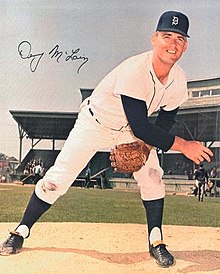
Dennis McLain, 1968 American League wins leader, with 31; this was the last time a pitcher has won thirty.
Major League Baseball recognizes the player or players in each league[a] with the most wins each season.[b] In baseball, wins are a statistic used to evaluate pitchers. Credit for a win is given by the official scorer to the pitcher whose team takes and maintains the lead while he is the pitcher of record. If a game is tied or if the lead changes to the other team, all pitchers who have participated and exited the game to that point are unable to receive credit for the victory. A starting pitcher is ineligible for the win unless he pitches at least five innings. (If he doesn't, but nevertheless leaves his team with a lead that it never relinquishes (a rather uncommon combination), the scorer would award the victory to the relief pitcher who was "most effective... in the official scorer's judgment".) (Full article...) -
Image 13

Tim Dillard is the Sounds' career leader in wins (48), games pitched (242), innings pitched (710), and strikeouts (437).
The Nashville Sounds Minor League Baseball team has played in Nashville, Tennessee, since being established in 1978 as an expansion team of the Double-A Southern League. They moved up to Triple-A in 1985 as members of the American Association before joining the Pacific Coast League in 1998. The team was placed in the Triple-A East in 2021 prior to this becoming the International League in 2022. In the history of the franchise, numerous players and teams have set records in various statistical areas during single games, entire seasons, or their Sounds careers.
Of the nine Sounds who hold the 19 career records tracked by the team, Tim Dillard holds the most, with seven. He is followed by Skeeter Barnes and Chad Hermansen, with three each; and Keith Brown, Mark Corey, Hugh Kemp, Otis Nixon, Tike Redman, and Joey Wendle, with one apiece. Dillard holds the most franchise records, with eight. He is followed by Jamie Werly, with six; and Steve Balboni and Skeeter Barnes, who hold four records each. (Full article...) -
Image 14

Ryne Sandberg has the most wins among National League second basemen with seven Silver Slugger Awards.
The Silver Slugger Award is awarded annually to the best offensive player at each position in both the American League (AL) and the National League (NL), as determined by the coaches and managers of Major League Baseball (MLB). These voters consider several offensive categories in selecting the winners, including batting average, slugging percentage, and on-base percentage, in addition to "coaches' and managers' general impressions of a player's overall offensive value". Managers and coaches are not permitted to vote for players on their own team. The Silver Slugger was first awarded in 1980 and is given by Hillerich & Bradsby, the manufacturer of Louisville Slugger bats. The award is a bat-shaped trophy, 3 feet (91 cm) tall, engraved with the names of each of the winners from the league and plated with sterling silver.
Among second basemen, Ryne Sandberg, who played 15 seasons with the Chicago Cubs in his 16-year career, is tied for the most Silver Sluggers all-time with seven wins, and is first among all National League second basemen, including five consecutive from 1988 to 1992. Three other National League players have won the award four times. Jeff Kent (2000–2002, 2005) won three consecutive awards with the San Francisco Giants, before adding a fourth with the Los Angeles Dodgers; Craig Biggio, who played his entire career with the Houston Astros, won the award four times as a second baseman (1994–1995, 1997–1998) after winning another as a catcher. Chase Utley followed Kent's last win by capturing four consecutive awards (2006–2009). (Full article...) -
Image 15

Location of Puerto Rico's main island (green)
Puerto Rico currently has the fourth-most active players in Major League Baseball (MLB) among Latin American jurisdictions, behind the Dominican Republic, Venezuela and Cuba. More than three hundred players from the archipelago have played in the major leagues since 1926. This includes players who were born in either one of the archipelago's islands and those of Puerto Rican heritage. Only those players who have worked in the major leagues are listed, not those active in the minor leagues, nor negro independent leagues.
For years, it was considered that the first player from Puerto Rico to play in the major leagues was Hiram Bithorn in 1942. But this changed in December 2020, when seven Negro baseball leagues between 1920 and 1948 were recognized as "major leagues." Thus, the first Puerto Rican to play baseball on the major leagues was Jose "Gacho" Torres, who debuted in 1926. (Full article...)
More did you know
- ... that umpire Bill Hohn once fist-bumped a player following the conclusion of a game?
- ... that Andy Dirks gained celebrity status in the Dominican Republic due to his performance in the Dominican Winter League's postseason?
- ... that baseball pitcher Darin Downs had to regain the ability to speak after being hit in the head by a batted ball?
- ... that President Barack Obama called to congratulate baseball pitcher Mark Buehrle after his perfect game?
- ... that Jean Segura stole first base?
Sports portals
Selected picture
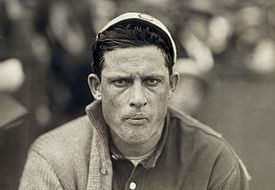
| Credit: Paul Thompson |
Edward Augustine Walsh (May 14, 1881 – May 26, 1959) was a Major League Baseball pitcher. He holds the record for lowest career ERA, 1.82. Born in Plains Township, Pennsylvania, Walsh had a brief though remarkable major league career. He made his major league debut in 1904 with the Chicago White Sox and pitched his first full season in 1906, going 17-13 with a 1.88 ERA and 171 strikeouts.
Associated Wikimedia
The following Wikimedia Foundation sister projects provide more on this subject:
-
Commons
Free media repository -
Wikibooks
Free textbooks and manuals -
Wikidata
Free knowledge base -
Wikinews
Free-content news -
Wikiquote
Collection of quotations -
Wikisource
Free-content library -
Wikiversity
Free learning tools -
Wiktionary
Dictionary and thesaurus
More portals
- Portals with triaged subpages from June 2018
- All portals with triaged subpages
- Portals with no named maintainer
- Automated article-slideshow portals with 51–100 articles in article list
- Automated article-slideshow portals with 501–1000 articles in article list
- Random portal component with 41–50 available subpages
- Automated article-slideshow portals with 201–500 articles in article list
- Random portal component with 11–15 available subpages
- Random portal component with 21–25 available image subpages







